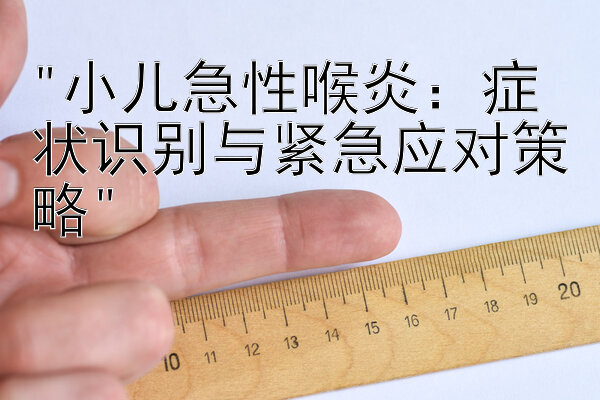小儿中耳炎是儿童时期最常见的疾病之一,它不仅会影响孩子的听力,还可能引起疼痛和不适感。了解小儿中耳炎的症状以及有效的治疗与预防方法,有助于家长及时发现并采取适当的措施来帮助孩子恢复健康。
一、小儿中耳炎的常见症状 1. 耳朵痛:孩子可能会抱怨耳朵疼或有不舒服的感觉。 2. 听力下降:由于液体在耳朵里积聚,导致听力受到影响,孩子可能听不清或误解别人说的话。 3. 抓挠耳朵:由于疼痛或不舒适感,孩子会频繁地用手去摸或拉扯耳朵。 4. 发热:中耳炎常常伴随着体温升高,这是身体对感染的一种反应。 5. 易怒或情绪变化:孩子可能会因为不舒服而变得烦躁不安或者比平常更加粘人。 6. 恶心或呕吐:有些孩子在严重的病例中会出现这些症状,这可能是因为炎症扩散到了平衡系统所致。 7. 失去平衡:如果炎症影响到内耳,孩子可能会有头晕或失去平衡感的现象。 8. 睡眠问题:耳朵的不适可能导致孩子晚上难以入睡或者夜间醒来次数增加。 9. 食欲减退:由于不适感和疼痛,孩子可能没有胃口吃东西。
二、有效治疗与预防小儿中ear infection in children is one of the most common illnesses, affecting not only their hearing but also causing pain and discomfort. Understanding the symptoms of pediatric otitis media as well as effective treatments and preventive measures can help parents recognize the condition early and take appropriate actions to support their child's recovery.
Common Symptoms of Pediatric Otitis Media:
- Ear Pain: Children may complain about ear pain or feel uncomfortable.
- Decreased Hearing: Due to fluid buildup in the ears, hearing can be affected, leading to difficulties understanding speech.
- Ear Tugging or Rubbing: Because of pain or discomfort, children might frequently touch or pull at their ears.
- Fever: Middle ear infections often come with an elevated temperature, which is the body's response to the presence of an infection.
- Irritability or Mood Changes: Discomfort can make a child more irritable or clingy than usual.
- Nausea or Vomiting: Severe cases might involve these symptoms due to inflammation spreading into the balance system.
- Loss of Balance: If the inner ear is affected by the inflammation, children could experience dizziness or issues maintaining equilibrium.
- Sleep Problems: Ear discomfort can lead to difficulty falling asleep or increased night waking.
- Appetite Reduction: The unpleasant sensation and pain associated with otitis media can reduce a child's appetite.
Effective Treatment for Pediatric Otitis Media:
- Antibiotics: These are typically prescribed if the infection is bacterial, aiming to clear up the infection quickly before it worsens.
- Pain Relief Medication: Over-the-counter medications like acetaminophen or ibuprofen can alleviate pain and fever caused by otitis media. However, always follow dosage guidelines provided by healthcare professionals.
- Warm Compresses: Applying warm compresses to the ear can provide temporary relief from pain and swelling.
- Oral Hydration: Encourage your child to drink plenty of fluids to stay hydrated, especially if they have been experiencing nausea or vomiting.
- Monitor Symptoms: Regularly check on your child's progress to ensure that treatment is working and that there aren't any complications developing.
Prevention Strategies for Pediatric Otitis Media:
- Immunization: Keeping your child up to date with vaccinations, including those against viruses known to increase risk (e.g., influenza), reduces overall illness and potential ear infection risk.
- Breastfeeding: Exclusive breastfeeding for the first year has been shown to offer some protection against middle ear infections.
- Avoid Passive Smoking: Secondhand smoke exposure increases the likelihood of recurrent episodes of otitis media.
- Keep Nasal Passages Clear: Using saline drops followed by suctioning with a bulb syringe can help keep nasal passages clear, reducing the chance of Eustachian tube blockage.
- Use Humidifiers: In dry environments, using humidifiers can moisten the air and potentially decrease the risk of throat and nose irritation, which can contribute to ear infections.
- Follow Good Handwashing Practices: Teach your child proper hand hygiene to reduce the spread of bacteria and viruses that can cause upper respiratory tract infections, which can then lead to middle ear problems.
It is crucial for parents to watch out for signs of pediatric otitis media so that they can seek medical advice promptly when necessary. Early intervention leads to better outcomes and minimizes the impact on a child's health and development.





